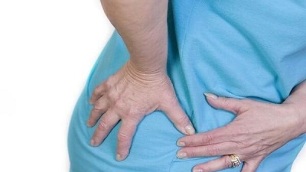
Arthrosis of the hip joint is a disease called coxarthrosis. The insidiousness of the disease is that it differs in an imperceptible course for a long time.
Symptoms may not alert the patient for more than two years, until they gradually worsen and force him to see a doctor.
Symptoms are divided into 3 degrees, depending on its severity.
Symptoms of the disease
The main symptom is joint pain while walking. Being chronic, coxarthrosis sometimes worsens - and then the pain becomes more pronounced. Localization is often in the groin area, on the outer side of the thigh, its front surface and echoes in the knee or in the buttocks. The pain causes a change in gait, as the patient adapts, trying to avoid pain. This can lead (especially in advanced cases) to a shortening of the leg. Let's consider the symptoms of arthrosis in more detail.
Attention!The disease mainly affects women.
Arthrosis of the hip joint - grade 1
It is characterized by mild, aching pain that occurs after significant physical exertion, mainly running or walking for a long time. The pain quickly disappears after rest, without disturbing the dynamics of movements, therefore it does not cause alertness in the patient. On the x-ray, small bone changes are visible - growth that does not go beyond the articular lip.
Arthrosis of the hip joint - grade 2
The pain becomes more intense, localized in the joint, radiating to the groin and thigh, appearing even at rest. The work of the joint is impaired, long walking causes lameness. Hip abduction and internal rotation are limited, and the muscles that allow hip abduction and extension become weaker.
Arthrosis of the hip joint - grade 3
Coxarthrosis pains bother the patient constantly, arising even at night. The muscles of the leg (thigh, lower leg) and buttocks atrophy, their volume decreases, while walking, a cane is needed. This leads to a shortening of the limb, the patient is forced to stand on his toes, leaning forward. At grade 3 of the disease, painful sensations are often stronger in the knee than in the groin or thigh, so the doctor may make a mistake with the diagnosis.
Causes of the disease
There are many reasons for coxarthrosis. Let's consider the main ones:
- Excessive stress on the joint, its injuries, especially often occurring in athletes.
- Hereditary diseases. These include congenital dislocation of the hip, hip dysplasia and others.
- Hereditary predisposition. Despite the fact that coxarthrosis is not transmitted genetically, a child can inherit a weak skeleton or structural features of cartilage tissue from relatives.
- Arthritis, even if healed, can provoke arthrosis of the hip joint.
- Chronic stress and long-term experiences, scientists say, have an extremely negative effect on joint health.
- A heart attack (aseptic necrosis) of the hip joint leads to circulatory disorders.
- Changes at the hormonal level, diabetes mellitus, loss of sensitivity of the lower limbs in nervous diseases.
Important!Significantly increases the risk of developing obesity. In 5-10% of cases, it is this that leads to the development of the disease.
Treatment with folk remedies
Bees
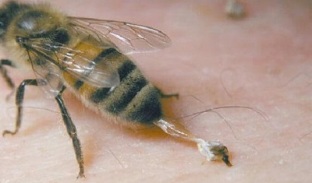
Apiproducts have established themselves as an effective treatment for many internal diseases. It is not surprising that bees are also able to help with deformation of the joints - bee venom has an anti-inflammatory and analgesic effect, normalizes the mobility of diseased joints, relieves swelling and prevents deterioration. Mainly bee stinging is used, which is prescribed only by a specialist. Therapy starts with one bite, but usually the result is visible after the first procedure. The poison acts on the site of inflammation, and helps the body to fight the infection on its own. In addition, it will help to cope with other problems of the body - eliminate infections, restore the functioning of the nervous system, and stop the aging of the body.
Mud Treatment
Mud wraps give positive results as a complementary therapy. The efficiency of heated mud is higher, therefore it is recommended to warm it up to 40 degrees before use. Apply a mud cake (clay diluted with water in a ratio of 1: 7) to the damaged joint and fix it with a sheet, oilcloth and warm it on top with a towel. The duration of the procedure is 30 minutes. Rinse it off with warm water and let yourself rest for half an hour. Perform wraps at least once a day for a month.
The following types of dirt are used:
- silt;
- peat;
- sapropel.
Gelatin Treatment
Gelatin is a natural substance used by humanity for centuries. Its main advantage is that it is not only useful, but also completely safe.
Attention!Gelatin helps to improve the condition of hair, eliminating dryness and hair loss, as well as increase the functionality of the whole body. To heal the hair, it is enough to dilute the powder with cold water and, letting it brew, dilute it in equal proportions with shampoo.
What are the benefits of gelatin for joints? It contains amino acids that add elasticity to the joints and slow down (or stop at all) their destructive changes. In terms of chemical composition, gelatin is collagen and is almost 90% protein, and protein foods are especially useful for joint problems.
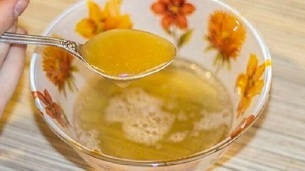
Patients taking gelatin note a decrease in the pathological process and the intensity of joint pain, which allows them to move more freely. Of course, it cannot be regarded as the main type of treatment, but in combination with other measures, it is very effective.
How to make gelatin:
- Pour a teaspoon of powder with half a glass of cold water (pre-boiled).
- Leave it to infuse - it should swell.
- In the morning, add hot water to one cup, and stir in a teaspoon of honey for sweetness and extra effect.
- After stirring, take the gelatin while still warm, in the morning on an empty stomach.
- Course: 10 days treatment / 10 days break for 3 months.
Leech Healing
Hirudotherapy (or treatment with leeches) gives positive results in the initial stages of the disease - I and II. The benefit of a leech bite is that its saliva contains enzymes, the action of which corresponds to the effect of drugs injected into the periarticular region. In addition, leeches improve blood flow in the area of the damaged joint.
At stage III of coxarthrosis, the use of leeches eliminates nocturnal joint pain and pain at rest. In the postoperative period, the recovery of damaged muscles and joints is accelerated.
The procedures are carried out with an interval of 2-6 days, the course includes 6-8 sessions. During the session, from 4 to 8 medicinal leeches are used. Already after 4 sessions, a noticeable improvement is observed, but the maximum effect is achieved approximately 2 weeks after the end of the course of hirudotherapy.
Herbs
Traditional medicine recipes are often the only way to eliminate a difficult disease. Herbs are applied both topically and internally. Some of them help even with grade III coxarthrosis.
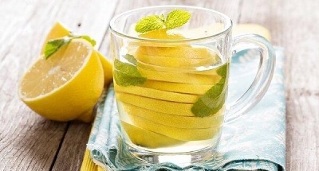
Recipe # 1:
- You will need lemon (3 pcs. ), celery (250 g), garlic (120 g).
- After grinding, place the ingredients in a 3-liter jar, cover with boiling water and warm with a blanket, leaving overnight.
- Take the medicine in the morning, 70 g daily, half an hour before meals, for three months. Banks are often enough for 1 month.
Stir and consume one glass each day for a month.
Attention!Before consuming lemon, make sure your stomach acid is not too acidic - citrus fruits increase it.
Recipe # 2. Take 3 lemons, finely chop them together with the peel, pour boiling water (three liters) and leave to cool completely, and then dissolve 3 tbsp. l. linden honey.
Tip!If your tendons and muscles are pulling, you can prepare celandine oil. Take 8 tbsp. l. flowers and stems of the plant, chop them and cover with 1 liter of olive oil. Let the oil sit in a warm place for 2 weeks. When it is infused, strain it and rub it into the painful areas, insulating them with a warm cloth.
Lapping for joint pain
Take equal proportions of iodine, glycerin, alcohol, and flower honey. After 2-3 hours, the drug will be ready. You need to use it by applying it on a cotton swab and rubbing it thoroughly into the skin in the area of the sore joint. It is necessary to lubricate the skin from the bottom up, along the flow of lymph and blood. The effectiveness of lapping will be higher if you additionally lubricate the tissues surrounding the area of inflammation - this will improve blood circulation and make the disease recede.
Cabbage
Cabbage compress will reduce pain in the injured joint. You will need a head of cabbage, from which you need to separate several large and fresh leaves before bed. Lubricate the area of inflammation with flower honey and attach the cabbage, and then fix it with a plastic bag and warm it with a towel or handkerchief. In the morning, wash off the remaining honey and repeat the procedure. You need to walk with a compress until the evening. Repeat the procedure for a month.
Mint
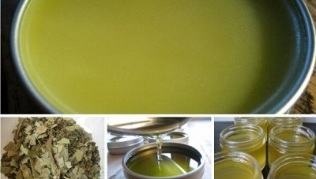
Peppermint ointment for joint pain.
Chop 50 g of mint and eucalyptus leaves with a knife, and then add 50 ml of aloe juice.
Stir the ingredients and lubricate sore joints 3 times a day.
Treatment without surgery
Sometimes patients come to the doctor with an extremely advanced stage of coxarthrosis. In this case, it is almost impossible to help them without surgery. However, medical practice shows that regular therapeutic exercises and the appointment of certain drugs can not only reduce the manifestations of the disease, but also almost completely eliminate them.
Treatment in this case is purely individual and consists, in addition to gymnastics, in taking drugs that strengthen bones. If the joint can still be saved, it makes sense to prescribe medication to restore the cartilage.
There are a number of alternative methods that help with coxarthrosis:
- Manual therapy.
- Applied kinesology (movement therapy).
- Hardware joint traction.
- Non-apparatus joint traction (post-isometric relaxation).
Preparations
The following groups of drugs help with this diagnosis.
Non-steroidal anti-inflammatory drugs. Despite the fact that they do not treat the disease itself, these drugs can effectively eliminate pain and reduce severe inflammation. Their constant intake is not recommended due to the harmful effects on the body.
Chondroprotectors, unlike NVP, not only relieve symptoms, but also affect the basis of the disease. They restore the structure of the cartilage, improve the production of joint fluid. However, they do not work immediately - it will take at least 2-3 courses to achieve positive results.
Attention! Chondroprotectors can only help in the early stages of the disease.
Muscle relaxants (muscle relaxants) are good for relieving spasm in the muscles surrounding inflamed tissue. They are effective in combination with joint traction and chondroprotectors, because if you do not start to restore the joint itself, relieving the spasm can lead to its accelerated destruction.
Tip!The doctor claims that muscleoxidants rarely help to significantly improve the patient's condition, because their appointment is far from always justified.
Vasodilators. They increase blood circulation in the joint, which contributes to its faster recovery, and also reduces pain, relieves vasospasm, and improves joint nutrition. To begin with, the tablets are taken one at a time, but after a few days, if there are no side effects, they switch to the course of administration recommended by the doctor.
Injections
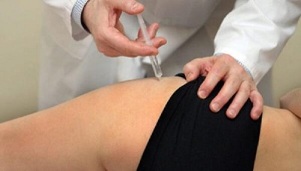
Injections are injected directly into the joint or periarticular tissue. However, most often the injection is not done into the lumen of the damaged joint, but into the periarticular tissue, since there is a high risk of overshooting, damaging the nerve endings.
- Corticosteroid hormones are administered to relieve pain.
- The introduction of chondroprotectors through the thigh is very useful (2-3 courses are carried out per year).
- Hyaluronic acid, an artificial joint lubrication, must be injected into the joint lumen, which is very difficult to get into, therefore, the treatment gives only 30% a positive effect.
Ointments
It is not so much ointments that are effective, which do not always reach the joint - the process of rubbing in the ointment itself often gives a positive effect, replacing a light massage. You need to rub the ointment with clean hands for 15 minutes. circular and spiral movements from bottom to top until a feeling of warmth appears.
The composition of the ointments is different - it can be plant raw materials, bee and snake venom, an extract of the cartilaginous tissue of cattle. Ointments with honey or mustard and other warming components in the composition will be good. You can even prepare such funds yourself. Ointments also have an analgesic effect.
Exercises
Therapeutic gymnastics is very effective in the initial stages of the disease, and sometimes it turns out to be effective even in advanced cases. The main purpose of the exercise is to develop the affected joint and strengthen the nearby muscles. If discomfort appears in the thigh area after gymnastics, massage should be performed to minimize discomfort.
Important!During gymnastics, do not load the joint - exclude its axial load, as it may worsen the condition. Also, try not to make sudden and deep movements.
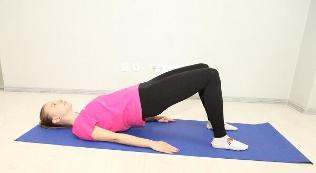
There is a whole range of exercises that are important to do regularly - in this case, the result will really be noticeable.
Here are some exercises.
- I. p. - standing. Grasp the support with both hands and slowly do a half-squat 10 times.
- I. p. - standing. Transfer your body weight to your healthy leg and support yourself with a hand on the same side (table or back of a chair). Slowly swing back and forth with your sore leg.
- I. p. - lying on his stomach. Place your hands on your hips and raise your straight legs alternately.
- I. p. - stand firmly on both legs and with both hands rest on the support. Rise on your toes and lower your heels to the floor. Perform - 10 times.
The set of exercises consists of three series and is performed slowly but surely for an hour. It is imperative to do the exercises correctly.
Diet
Proper nutrition is one of the keys to success in any disease, including arthrosis. Here are some products that will help restore cartilage tissue and do not provoke weight gain:
- low fat milk and fermented milk products;
- lean meat and fish;
- buckwheat;
- beans, lentils.
- Fats are essential for normal metabolism. Give preference to unrefined vegetable and butter oils, fish or shark oil.
- Carbohydrates fill the body with energy. It is better to eat complex carbohydrates (vegetables, fruits) than simple ones, which include sugar and other sweets.
- Minerals and vitamins are found in foods such as baked potatoes, bananas, nuts, eggs, chicken meat, whole grain bread.
Doctors advise to consume no more than 1 teaspoon of salt per day, give up preservatives, smoked meats and other unhealthy foods high in fat.
Tip!Water is life. For coxarthrosis, drink plenty of water - up to two liters a day.
Prevention
Prevention consists in an active lifestyle, proper nutrition, avoiding excessive stress on the joints (which athletes often abuse). Be healthy!

























